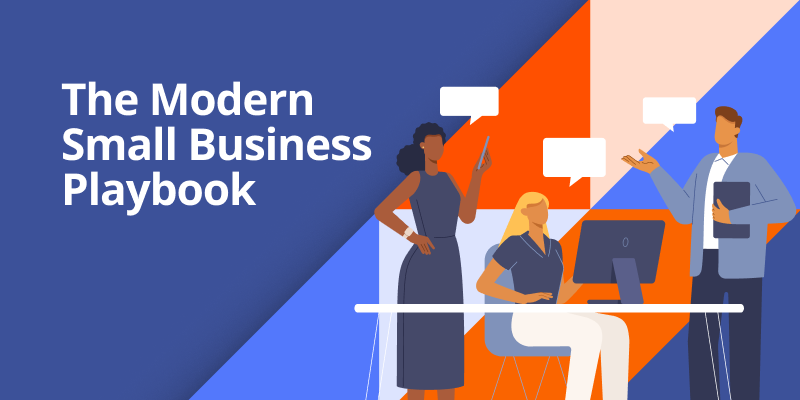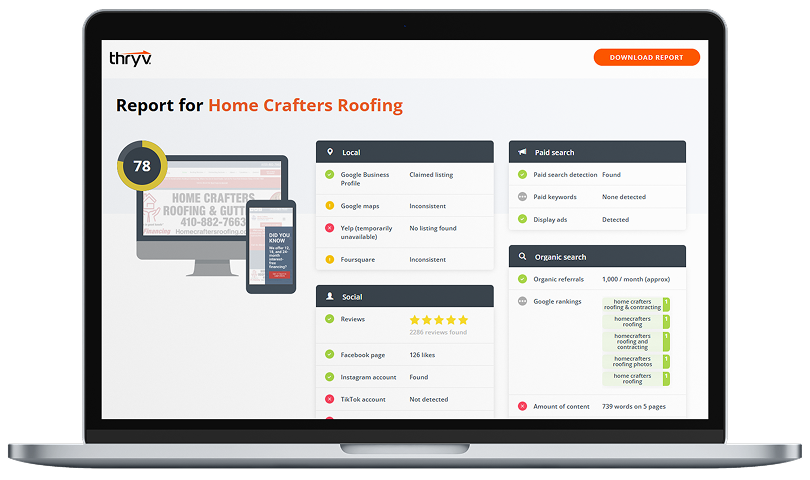You might have a “circle of trust” with your friends and family, but what about a “Triangle of Trust” with your customers?
Geometrical differences aside, these two concepts aren’t so different. You trust your loved ones to meet your expectations, and your customers expect the same from your business. This dynamic is based on a “Triangle of Trust,” which is composed of three key elements: authenticity, empathy, and logic.

Free Guide: Modern Small Business Playbook
Learn how to modernize your business and make meaningful connections with customers.
Save NowThis post will explain the Triangle of Trust and why it matters to small business owners. We’ll also discuss the components of a Trust Triangle and how you can build trust with your customers at your company.
Triangle of Trust Meaning
The “Triangle of Trust” is a visual representation of how businesses build trustworthy relationships with customers. The triangle has three points, each representing a different component needed to build trust: authenticity, logic, and empathy.
The Triangle of Trust shows how these points are connected and rely on each other. For example, you can have a great product and marketing campaign, but if you have bad reviews, people aren’t going to trust you. You need to strengthen your messaging within these points to develop long-term connections with your customer base.
The famous educator, author, and businessman, Stephen Richards Covey, once described trust as:
If you think about it, every transaction is an act of trust. Consumers are looking for signs they can trust you before they purchase something, which is why reviews and testimonials matter so much. And, like it or not, it takes several transactions to build trust and only one moment to lose it.
State of Consumer Trust
For more than 20 years, Edelman, a global communications firm, has been assessing the state of consumer trust worldwide. Below is a chart that shows how trust in media outlets (search engines, social media, traditional media, owned media) has changed in the last 10 years.
As you can see, consumer trust is generally on the rise. Search engines like Google continue to be trusted sources of information, and owned media outlets (e.g., blogs like this one) are also gaining popularity.
Consumer trust in social media and traditional media channels has declined over the last 10 years. However, trust has steadily increased in these outlets over the last four years. That’s likely due to the tumultuous years that occurred between 2020-2021, with an election cycle, a global pandemic, and much more. But since then, trust has increased and continues to grow each year.
Let’s look at the components of a Trust Triangle and discuss what small businesses need to do to forge meaningful connections with their customers.
What Are the Components of the Trust Triangle?
The three components of the Trust Triangle are authenticity, logic, and empathy. Let’s review each in more detail.
Authenticity
Authenticity is your brand’s believability. When people interact with your marketing campaigns, they should feel like your advertisements are genuine and sincere. Sure, you should promote your products and services, but do it in a way that’s honest and in line with your brand values.
For example, birddogs is a clothing company that was featured on Shark Tank in 2018. People fell in love with the authentic advertising and were drawn to the brand’s provocative sense of humor. Here’s an example from its “About Us” page, which pokes fun at each company member.
birddogs has a great product, but customers love its brand story as well. It’s unique from other clothing companies and makes the shopping experience more fun.
Your brand doesn’t have to be funny. It can be heartwarming, professional, or whatever resonates with your customer base. It just needs to be authentic to who you are as a business.
Logic
Logic means that people trust your business will meet their needs. It involves product quality and the marketing of your products and services.
For example, the slogan “Built Ford Tough” highlights how durable Ford trucks are. It positions the brand as a work vehicle that can tow large payloads and navigate rough terrain. If we look at the product page for an F-150, we can see the key features include a “PowerBoost®” V6 engine and backup assistant for towing trailers.
These features and the brand’s messaging show customers that these vehicles are capable of towing and off-road driving. Consumers looking for a work truck will see these advertisements and feel more confident that a Ford will meet their needs.
Empathy
Let’s be real. No matter your reason for being a business owner, earning money and making a living still matters. But, revenue can’t come at the expense of customer satisfaction. You have to care about your customers, especially as a small business owner who forges connections within a local community.
Empathy is directly tied to customer care. If you prioritize customer needs, you’ll make people happier, and they’ll want to shop with you again. They’ll trust that your brand has their best interests at heart and might be more likely to choose you over a competitor as a result.
As a small business owner, here’s where you have an advantage over bigger brands. You control your company’s ways of doing things, and you can make real connections with customers who live in your area. You also can offer special discounts and be more flexible on deals than a corporate franchise can. Sure, you might make a little less in the short term, but you’ll gain loyal customers (and repeat business) in the process. That leads to good reviews and customer referrals that generate revenue for your business.
How to Build a Trust Triangle at Small Businesses
Here’s a list of key behaviors that lead to trust. Audit your business to see if your company practices each one.
- Customer Focus: This means prioritizing the outcomes and benefits of the customer.
- Collaboration: Collaboration means working with the customer. The better you collaborate, the better the outcome.
- Commitment: Trust is a natural outcome if you forge long-term relationships instead of short-term transactions.
- Transparency: Transparency increases one’s credibility and can help keep the focus on others, like customers.
- Integrity: If you say you will do something, you should do it. Basic integrity leads to long-term trust.
- Communication: Frequent, honest communication with customers, suppliers, and employees creates a solid foundation of trust.
- Consistency: Trust takes time to earn. Yet, you can lose trust in a moment because of one poor decision.
- Customer Satisfaction: Focus more on your core values and customer loyalty than short-term sales and profits.
- Teamwork: When people trust their team members, they’re more likely to work harder and do it for the good of the team.
- Coaching: Coach your customers. Coach your team at work. Guide people and educate them on what you know.
- Empathy: When people know you care about their interests as much as yours, they trust you more.
- Honesty: When you don’t do the right thing, admit it. Be transparent, authentic, and willing to share your mistakes and faults.
Building Your Trust Triangle
Fostering trust in your local community is important as a small business owner. It will make your brand more reputable and help you attract more customers. Use the tips in this post to forge a strong trust triangle with your most loyal clients, leading to better brand experiences and repeat purchases for your business.

Modern Small
Business Playbook
Find expert tips and tools to help you streamline communications, automate your marketing efforts, improve your business operations, and more in this free guide.


